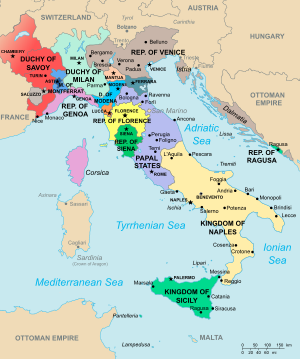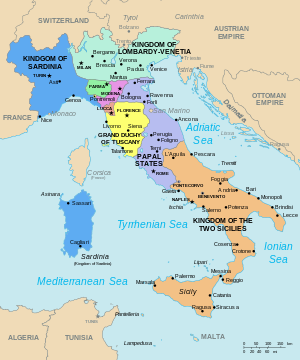Cesi family
| Cesi | |
|---|---|
 | |
| Country | |
| Current region | |
| Place of origin | Cesi, Terni |
| Founded | X century[1][2][3][4] |
| Founder | Pope Sylvester II[1][2][5] |
| Titles |
|
| Motto | Omnibus Idem |
| Estate(s) |
Public Monuments:
|
| Cadet branches | Marquis Cittadini-Cesi, Dukes of Acquasparta |
The Cesi family is an Italian noble family which belonged to the high aristocracy of Rome and the Papal States.[10][11]
Origins

The Cesi family takes its surname from Cesi. The fiefdom of Cesi was originally part of the Lombard Duchy of Spoleto. The Cesi fief was of the Arnolfi family, the chief seat of the Terre Arnolfe.[12] The Arnolfi family claimed descent from the Lombard Arnulf, vassal of Duke of Spoleto. The duchy was then annexed to the Papal States.[13] It comes from the Latin word caesi and the Latin verb caedere. Contraction of the Lombard toponym Cesina, which indicated a coppice wood or a place cleared of woodland.
History



According to the "Relation de Rome" of the French Ambassador to the court of
The last of Pietro's sons, Angelo or Agnolo, married Franceschina Cardoli, a descendant on his mother's side of the famous condottiero
Giangiacomo, Angelo's son, was decemvir at
.Giangiacomo's son, Angelo, followed in his father's footsteps and was also a
His sons were
Federico (1562–1630), was the eldest son of the former and 2nd Duke of Acquasparta. His brother Firmino, became
The family grew and prospered until the second half of the 17th century when it sold most of its property to the Borghese family. At this point the branch of the dukes of Acquasparta was succeeded by the one originated by Bartolomeo with Giacomo di Giuseppe who in 1804 and then with his son, Luigi in 1821.
The Pierdonato branch ruled with the title of marquis and duke in several fiefs in the Sabina area, dying out in 1657 with the death of Francesco Maria Cesi, duke of Ceri and Selci, titles that returned to the main branch of the lineage.
Family tree
This section is empty. You can help by adding to it. (March 2024) |
Notable members
Cesi cardinals
- Paolo Emilio Cesi (1481–1537)[16]
- Federico Cesi (1500–1565), younger brother of Cardinal Paolo Emilio Cesi.
- Pier Donato Cesi (1521–1586), seniore (senior)
- Pier Donato Cesi (1583–1656), iuniore (junior)
- Bartolomeo Cesi (1566–1621)
Cesi bishops
- Bishop of Narniuntil his death in 1537.
Cesi nobles
Princes of San Polo and Sant'Angelo (1613-1670), Dukes of Acquasparta and Marquesses of Monticelli (1588)
- Federico I Cesi (1562–1630), I prince of San Polo and Sant'Angelo, I duke of Acquasparta, I marquis of Monticelli.
- Federico II Cesi (1585–1630), II prince of San Polo and Sant'Angelo, II duke of Acquasparta, II marquis of Monticelli, scientist, naturalist and founder of the Accademia dei Lincei.[17]
- Giovanni Cesi (died 1656), III prince of San Polo and Sant'Angelo, III duke of Acquasparta, III marquis of Monticelli.
- Federico III Cesi (died 1666), IV prince of San Polo and Sant'Angelo, IV duke of Acquasparta, IV marquis of Monticelli
- Giuseppe Angelo Cesi (died 1705), V prince of San Polo and Sant'Angelo, V duke of Acquasparta, V marquis of Monticelli. The fiefdom of San Polo and Sant'Angelo is sold with the relative title to the Borghese princes; the other titles of duke and marquis remain active.
- Federico IV Pierdonato Cesi (died 1762), VI duke of Acquasparta, VI marquis of Monticelli.
- Carlo Federico Cesi (died 1774), VII duke of Acquasparta, VII marquis of Monticelli.
- Federico V Cesi (1766–1799), VIII duke of Acquasparta, VIII marquis of Monticelli.
- Giacomo Cesi (died 1821), IX duke of Acquasparta, IX marquis of Monticelli.
- Luigi Cesi, X duke of Acquasparta, X marquis of Monticelli.
- Federico VI Cesi, XI duke of Acquasparta, XI marquis of Monticelli.
- Gerberto, XII duke of Acquasparta, XII marquis of Monticelli.
- Elvira, duchess of Acquasparta, married Marquis Gaspare Cittadini and gave rise to the Cittadini-Cesi lineage.
Dukes of Selci (1596) and of Ceri (c. 1612)
- Paolo Emilio Cesi (d. 1611), II duke of Selci (title acquired from the Orsini)
- Andrea Cesi (d. 1626), I duke of Ceri, III duke of Selci
- Francesco Maria Cesi (d. 1657), II duke of Ceri, IV duke of Selci. Upon his death, the title of Duke of Selci passed to the main family branch, while that of Duke of Borromeo family.
Matrimonial alliances
 Sources:[1][2][6][18][19][20][21][22][23]
Sources:[1][2][6][18][19][20][21][22][23]
Don Giangiacomo (+1455)
= Donna Isabella d'Alviano, daughter of Count Bartolomeo d'Alviano and Pentesilea Baglioni dei Counts of Spello and Bettona
Don Angelo (1542–1570)
= Donna Beatrice Caetani, daughter of Don Bonifazio I 4° Duke of Sermoneta and of Caterina Pio di Savoia dei Princes of Carpi
Don Federico I (1562–1630)
= Donna Olimpia Orsini, daughter of Giovanni 2° Marquis of Lamentana and Porzia dei Counts dell'Anguillara
Don Federico II (1585–1630):
= Donna Artemisia
= Donna Isabella Salviati, daughter of Lorenzo Marquis of Giuliano and Donna Maddalena Strozzi dei Princes of Forano
Donna Olimpia (1618)
= Ludovico Lante della Rovere Marquis of Massa Luense
= Paolo
Donna Caterina (1637)
= Giulio Della Rovere dei Marquis of San Lorenzo
Paolo Emilio (+1611)
= Porzia dell'Anguillara, daughter and heiress of Giampaolo dei Counts dell'Anguillara and Margherita Orsini dei Princes of Taranto
= Costanza degli Atti
Don Andrea (+1626)
= Donna Cornelia Orsini, daughter of Don Virginio Duke of San Gemini and Donna Giovanna Caetani dei Dukes of Sermoneta, already widow of Don Roberto Altemps Duke of Gallese
Don Francesco Maria (+1657)
= Giulia Pico Princess of Mirandola, daughter of Prince Alessandro Pico della Mirandola and Laura d'Este Princess of Modena and Reggio
= Donna Anna Caterina
Donna Maria
= Don Giovanni Angelo d'Altemps, Duke of Gallese
Don Giovanni (+1656)
= Giulia Veronica
Donna Isabella (1676–1753)
= Don Francesco
Romolo (+1573)
= Timotea Orsini dei Dukes of San Gemini
= Venere D'Evoli dei Princes of Castroprignano
Donna Lucrezia (1577+)
= Giulio Landi Prince of Val di Taro
Donna Isabella
= Duke Ludovico Lante Montefeltro Della Rovere, Marquis of Massa Luense
Don Giuseppe Angelo (+1705)
= Donna Giacinta Conti, daughter of Don Carlo Duke of Poli and Guadagnolo and Donna Isabella Muti dei Dukes of Rignano
Don Federico Pierdonato (+1762)
= Donna Silvia Maria Teresa
Don Carlo Federico (+1774)
= Maria Vittoria Spada, daughter of Marquis Clemente of Caste Viscardo and Maria dei Counts Rocci
Don Federico (+1771)
= Maria Anna Massimo, daughter of Marquis Emilio Massimo and Maria dei Counts Bernardini Ferretti, who became heiress to the Cesi's Dukes of Rignano title, and transmitted it to her nephews from the Massimo family
Don Federico (+1799)
= Matilde Malatesta, daughter of Felice Antonio Count of Sogliano
Donna Nicolosa (1550+)
= Onofrio Santacroce, Duke of San Gemini
Pietro Donato detto Pierdonato (+1504)
= Lucrezia degli Atti
Paolo Emilio (+1611)
= Porzia dell'Anguillara, daughter and heiress of Giampaolo Count dell'Anguillara and Margherita Orsini dei Princes di Taranto
= Costanza degli Atti
Donna Anna Maria (+1647)
= Don Michele Damasceni Peretti, Prince of Venafro
Don Marcantonio
= Paola Savelli dei Princes of Albano, daughter of Tullio Savelli and Violante Orsini
Don Federico (+ 1620)
= Olimpia Orsini, daughter of Giordano Orsini Duke of San Gemini
Francesco (+1646)
= Margherita
Giovanni (+ 1531)
= Camilla Spada dei Marquis of Gerbeuville
References
- ^ a b c d I Cesi. Genealogia e Cronistoria di una Grande Famiglia Umbro-Romana, Edoardo Martinori
- ^ a b c I Cesi. Storia e Cronistoria di una Famiglia Nobile di Acquasparta
- ^ Memorie Historiche della Terra di Cesi, Raccolte da Monsignor Felice Contelori
- ^ Angelus Caesius Episcopus Tudertinus, Alessandro Fortunati
- ^ Gerberto o Sia Silvestro II Papa ed il Suo Secolo, del Dottore C. F. Hock
- ^ a b Libro d'Oro della Nobiltà Mediterranea
- ^ "Castello Marco Simone".
- ^ "RomaSegreta.it". 5 May 2013.
- doi:10.1086/703917.
- ^ "Cèsi". treccani.it. Retrieved 8 September 2022.
- ^ "The Galileo Project".
- ^ "ARNOLFE, TERRE". treccani.it. Retrieved 8 September 2022.
- ^ "PATRIMONIUM SANCTI PETRI". treccani.it. Retrieved 8 September 2022.
- ^ a b c d e f g h i j "La famiglia Cesi". difesa.it (in Italian).
- ^ a b Garollo (1907), p. 509
- ^ "CESI, Paolo Emilio". treccani.it. Retrieved 8 September 2022.
- ^ "Cèsi, Federico, detto il Linceo". treccani.it. Retrieved 8 September 2022.
- ^ Federico Cesi e la fondazione dell'Accademia dei Lincei
- ^ Memorie Istorico Critiche Dell'accademia De'lincei E Del Principe Federico Cesi, Secondo Duca D'aquasparta, Fondatore E Principe Dell'Accademia dei Lincei
- ^ I Testamenti dei Cardinali: Pietro Donato Cesi (1583-1656)
- ^ Galileo, lince tra le stelle. Un grande scienziato all'Accademia di Federico Cesi
- ^ All'origine della scienza moderna: Federico Cesi e l'Accademia dei Lincei
- ^ Il Palazzo Cesi di Acquasparta e la Rivoluzione Scientifica Lincea
Bibliography
- Theodore Amayden (c. 1620). Relation de Rome (in French).
- Gottardo Garollo (1907). Dizionario biografico universale (in Italian). Vol. 1. Milano: Ulrico Hoepli.
